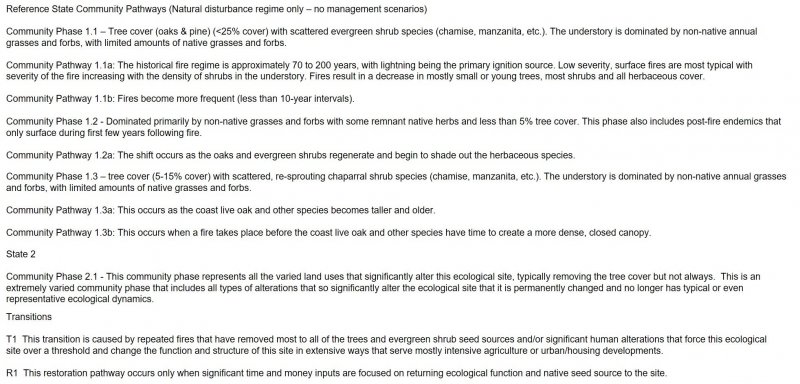Ecological site group F014XG925CA
Sandy Upland
Last updated: 09/07/2023
Accessed: 12/21/2025
Ecological site group description
Key Characteristics
None specified
Provisional. A provisional ecological site description has undergone quality control and quality assurance review. It contains a working state and transition model and enough information to identify the ecological site.
Physiography
This ESG is typically found on sloping to very steep hills formed in marine and wind modified marine sediments and soft sandstone formations. The elevations range from 250 to 1,500 feet.
Climate
The average annual precipitation in this area is 11 to 53 inches (272 to 1,353 millimeters), this site is on the higher end at 35 to 50 inches. The higher amounts of precipitation occur at the higher elevations in the area north of San Francisco. Most of the rainfall occurs as low- or moderate-intensity, Pacific frontal storms during winter. This area is very dry from midspring to midautumn. Snowfall is rare. The average annual temperature is 54 to 61 degrees F (12 to 16 degrees C). The freeze-free period averages 315 days and ranges from 265 to 365 days. It is longest near the coast, and it becomes shorter with elevation.
Soil features
Soils in this ESG soils are deep, somewhat excessively drained sandy soils that formed in weakly consolidated marine sediments. The soils are fine sand textures.
Some representative soils include:
Zayante, a sandy, mixed, mesic Humic Dystroxerept
Vegetation dynamics
This ESG covers the areas of the valleys in MLRA 14 that are on the transition zone with MLRA 4B or 15, and will be a mix of pines or oaks, chaparral shrubs and perennial and non-native annual grasses and forbs. The urbanized landscape in the valleys within this MLRA that exists today makes it difficult to imagine the full extent and dynamics of this natural landscape prior to human development.
These sandy upland areas that received significant spring water run-on from upslope watershed water. Once the area began to be settled, much of this site was cleared for agriculture and urbanization. As this landscape became houses and agriculture, the water table for many of these habitats moved deeper and deeper, creating soils that were more susceptible to invasion by non-native annual species which also increased fire frequencies. These well drained sandy soils would have transitioned to an altered state with the removal of the yearly groundwater sources, due to lower water holding capacities during the warmest parts of the growing season. The coarser textures will dry out through both drainage and evapotranspiration in the summer months making them less hospitable for many of the native plants and more dominated by annual grasses and forbs, these lower water-holding textures will have a lower resistance to disturbance. Annual production will vary depending on the soil texture and proximity to groundwater sources.
Historically, this site may have looked similar to the CWHR oak woodlands and chaparral, however with the introduction of non-native annual grasses and the impacts from fragmentation, extensive agriculture, continued de-watering, and human alterations such as homes and roads, this site now reflects a lower producing, dry, oak grassland with scattered pines.
Currently, where this site is not under cultivation or urban developments, it is dominated by oaks, chaparral shrubs, and an understory of non-native annual grasses. These include wild oats, soft chess, ripgut brome, red brome, wild barley, and foxtail fescue. Common forbs include broadleaf filaree, redstem filaree, turkey mullein, true clovers, bur clover, popcorn flower, and many others. Perennial grasses will be found in moist, lightly grazed, or relic prairie areas. Species composition is also related to water availability with greater amounts of relic perennial grasses in areas of greater precipitation or soil moisture.
Information from:
John G. Kie
California Wildlife Habitat Relationships System
California Department of Fish and Game
California Interagency Wildlife Task Group
Major Land Resource Area
MLRA 014X
Central California Coastal Valleys
Stage
Provisional
Click on box and path labels to scroll to the respective text.

